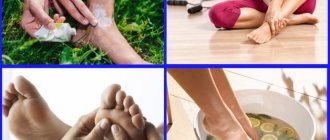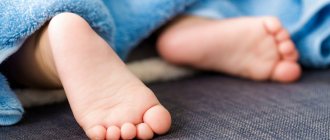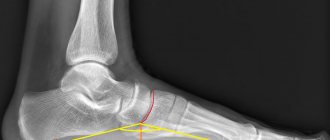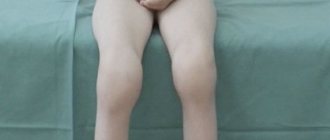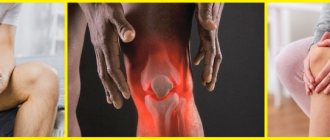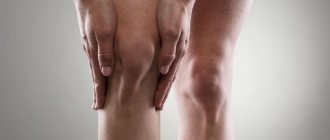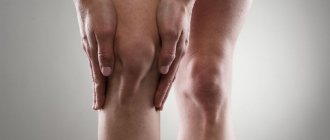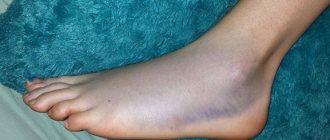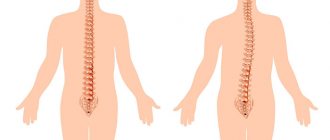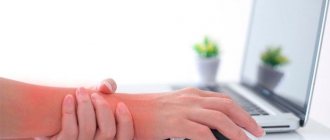- What it is
- Reasons for appearance
- What is the foot made of in children and what are the health consequences of flat feet?
- Factors that cause pathologies to develop
- Main symptoms
- Features of appearance in young children
- Diagnostics
- Controlling foot development
- Danger of disease
- Treatment
- Gymnastics (3-4 years and 5-6 years)
- About classroom supplies
- About the treatment of pathology in adolescents
- Causes of occurrence in adolescents
- Exercise therapy for teenagers
- About massage
- About the mode
This is the most common lesion of the osseous-ligamentous apparatus. At the same time, many parents are not aware of the problem because they believe that it does not affect later life, which is fundamentally wrong. If the disease is not detected in time, then in the future you will encounter deformities of the legs, knee joints, scoliosis, osteochondrosis and displacement of internal organs. So what to do and what treatment to choose if you found out about your child’s flat feet at 3-4 years old and at 5-6 years old, we will tell you below.
Why does it appear
In 90% of this, incorrectly selected shoes are to blame, for example, due to the lack of shock absorption and instep supports. Parents also often select models for growth, which also deforms the foot. The obesity and high weight of the child create more pressure on the legs, the growing body cannot withstand this, and this disease occurs.
Therefore, it is important to choose good orthopedic and preventative summer, winter and demi-season shoes from us - Ortopanda has a large selection of comfortable models made from corrective materials.
What is the foot made of in children and what are the health consequences of flat feet?
In medicine, there are three types:
- tarsus (posterior - talus, calcaneus, anterior - three scaphoid and cuboid), includes 7 bones;
- metatarsus (five tubular bones), responsible for the functioning of the fingers and the correct location of the arch;
- fingers - 14 bones, thanks to this zone the body maintains balance and can move evenly.
The bones are connected by joints and ligaments. The ankle bears the most weight when walking because it connects three bones. Ligaments are responsible for the correct arch; they distribute the load. The main task of all components of the human leg is to absorb the load and make it uniform. When all parts of the foot are used, this is possible, but few people experience this.
With diseases of the lower extremities, the longitudinal and transverse arches weaken, they can no longer support weight. As a result, the entire load falls on large joints and ligaments, which leads to arthritis, back problems, and arthrosis.
Therefore, if you are faced with this for the first time, and do not know the principle of treatment and what to do if a 7-year-old child is diagnosed with flat feet before going to school, immediately contact an orthopedist.
Medical diagnostics
Detection of flat feet by a doctor is usually carried out taking into account the methods listed above. But the doctor knows their technique much better, and also compares objective data with the description of the manifestations obtained after questioning. Often the disease is detected completely by accident - during preventive medical examinations.
Since pathology most often develops in adolescence, doctors’ efforts are aimed at its timely detection and treatment. For an experienced doctor, a simple examination of the feet in different positions is enough to suspect their flattening. Therefore, he no longer needs to carry out special tests, and the patient is immediately sent for an image.
X-ray method
Errors in external examination are usually due to the different thickness of soft tissues in each patient. This makes it difficult to use standard values that provide an accurate determination of the degree of flatfoot. And on the x-ray, all anatomical formations are immediately visible, serving as landmarks when assessing angles:
To begin with, a triangle is again constructed, in which there are standard points - the top of the calcaneal tubercle, the head of the first metatarsal bone and the lower edge of the scaphoid bone. Only one corner located at the top of the figure is evaluated. Normally it is between 120 and 130 degrees. With the first degree of flatfoot, there is a decrease in this value to 140. The second stage of the disease leads to a further decrease in the height of the arch of the foot - with the upper angle ranging from 140 to 155. Severe flatfoot is accompanied by a significant flattening of the triangle - the required figure becomes more than 155 degrees.
An auxiliary value in the study is the determination of the height of the arch of the foot, which is also assessed on an x-ray. Normally, the line drawn between the most distant points is more than 35 millimeters. As the pathology develops, its progressive decrease is observed.
To begin with, it is worth defining the disease. These are changes in the position of the foot that appear in connection with the lowering of the longitudinal or transverse arch of the foot. With this disease, the shock-absorbing effect of the leg is lost. Therefore, the entire load is transferred to the hip joint and back. Simply put, it is a flattening of the foot resulting in painful effects and skeletal complications.
The essence of the shock-absorbing effect is that when walking, the load is distributed evenly between the joints and the spine.
Causes of occurrence in children and factors that cause pathology
There are many situations that in one way or another affect the health of children's feet. The main factors that can provoke the development of the disease, but do not yet guarantee its occurrence:
- heredity - if mom or dad had such problems, then the child will have to immediately purchase preventative shoes and engage in therapeutic exercises;
- foot injuries;
- excessive load (due to large body weight or initial obesity, during weightlifting, with constant weight lifting);
- rickets;
- muscle weakness due to insufficient physical development, lack of physical education;
- paralysis (for example, cerebral palsy).
Studies have been conducted that urban children who constantly wear shoes (rather than barefoot) develop this disease more often than their rural peers. In addition, due to the lack of physical activity, instead of which smartphones and computers are used, posture is disturbed, which also affects the appearance of problems of the lower extremities.
How to prevent flat feet
Prevention of the disease consists, first of all, of regular but moderate physical activity. The simplest and most effective exercise is alternating walking on your toes and heels, which you need to do every morning and every evening. Running in the morning several times a week is also a good prevention of flat feet. It is important not to get carried away with excessive physical activity, since its excess, as well as its deficiency, can lead to a dangerous illness.
A set of certain movements, however, can help not only prevent the disease, but also alleviate the symptoms of an existing disease. Regular barefoot walks on grass, sandy beaches, and pebbles are no less beneficial for your feet. The foot muscles are also well trained when swimming crawl, breaststroke and other styles that actively involve the legs.
An important factor influencing the occurrence of flat feet is the correct choice of shoes: uncomfortable lasts, narrow shoes or high heels when worn regularly can lead to foot disease.
Evening warm baths help improve blood circulation in the legs. They are also good for relieving tired legs. A weekly massage, which relaxes the muscles well, will not harm your feet.
In the initial stages, flat feet do not seem to us to be something serious, capable of limiting life activity and causing pain. It is important to remember that this is a serious disease, and if left untreated, it can cause a lot of problems. Therefore, flat feet should be identified as early as possible. Constant home monitoring can help you with this. Therefore, do not ignore the health of your feet and be sure to monitor your children’s gait.
The main symptoms of flat feet in children and its types
Most signs are visible to the naked eye. The parent himself can determine them:
- uneven wear of heels in a child over 5 years old;
- complaints of fatigue when walking, pain in the back and legs;
- clubfoot;
- stepping on the inner edges of the sole.
If each of them is detected or periodically repeated, you must make an appointment at the clinic with a therapist or orthopedist and consult about complaints.
Moms and dads can independently determine by the direction of spreading:
- increase in the transverse size of the feet;
- change in longitudinal length;
- increase both along and across the leg.
How to diagnose flat feet at home
This diagnosis is usually made by an orthopedic surgeon. But there are several ways to determine flat feet at home. Of course, if suspicions are confirmed, a visit to an orthopedist is still necessary. After all, the disease cannot be neglected, as this can lead to quite disastrous consequences.
The simplest and most accurate way to determine the presence of flat feet is as follows. You need to take a rich cream and apply it to the entire surface of the foot (both feet are lubricated at once). Then you need to stand with your feet on a white sheet of paper. You should stand straight, without leaning on anything: this is the only way the result will be correct. Fingerprints will remain on the paper, which will indicate the presence of the disease. For example, there you can see the size of the recess located on the inside of the foot, which should be at least half of its width.
If the notch is smaller or absent at all, this indicates the presence of flat feet. Instead of cream, vegetable oil or a weak solution of brilliant green can be used. In clinics, a similar test is used using a special device - a plantograph. It is a frame covered with polyethylene. A layer of ink is applied to it, on which a blank sheet is placed. Prints obtained this way are the most accurate.
It should be remembered that this method is only suitable for adults, since in children under 5 years of age the foot is not fully developed and has a protective fat layer. In this case, only a specialist can determine the presence of the disease.
The next method is also based on studying the foot print. It is necessary to draw a straight line between the center of the base of the big toe and the middle of the heel. Then you need to fix the distance between the center of the heel and the point located between the bases of the middle and index toes. If the narrowest place on the foot is located outside the boundaries of both lines or is within the boundaries of the second, there is no flatfoot. If the notch ends between the drawn lines, most likely you have first degree flat feet. If the studied contour extends beyond both lines, this indicates the second, and maybe third degree of transformation of the foot.
Another well-known method, which is often used by orthopedic doctors, is the Friland method. In this case, the height of the foot is multiplied by its length. The result should be at least 29-31. If the numbers are in the range of 27-29, you may have flat feet. A reading below 25 means pronounced flat feet. The operation of the device, the podometer, is based on the same method.
The degree of susceptibility to flat feet can be determined by the shape of the foot.
If the second toe is longer than the others and the foot is of average width, flat feet are unlikely to occur. A wide foot in combination with the first toes of equal length indicates that the development of flat feet is extremely likely. A narrow foot and long big toe indicate a risk of flat feet of approximately 50%.
Peculiarities of manifestation in children of different ages
Until the age of two, children's feet are not formed, this is due to the physiological characteristics of the body that has not yet become stronger: bone tissue contains very few minerals, ligaments and muscles are poorly developed. In the first years of life, the fat layer becomes a shock absorber.
In the period from two to three years, muscle tissue becomes stronger, legs are formed up to 6 years. It is difficult to make an accurate diagnosis during this period, so prevention is indispensable - buying shoes with arch supports, corrective exercises, therapeutic exercises. It is advisable to periodically visit an orthopedist.
After 6 years, you should constantly consult a doctor. Since in 90% this is not a congenital problem, but an acquired one.
Development of flat feet. Degrees of the disease
Flat feet do not occur suddenly; the development takes quite a long time and can be divided into 3 degrees:
Degree 1
The bones of the foot are not yet deformed and the arch of the foot is not flat, but the weakness of the ligaments is already felt, the legs get tired faster than before, the posture changes due to the fact that the legs ache almost constantly.
Degree 2
At this stage, the arch of the foot is already changing; it becomes lower by 15-25 mm. The pain is more frequent and more intense, and it spreads to the lower leg and ankle. The gait becomes heavy.
Degree 3
The foot is noticeably changed. Even short walks end in excruciating pain and swelling in the legs. The lower back and, often, the head hurt.
Diagnosis and impact on the child
The problem may develop asymptomatically. However, every year the baby will complain of pain and fatigue. There will be cramps, swelling, and sometimes even visible deformation. The doctor makes a direct diagnosis after interviewing the parents, the child, and a visual examination. Examined upon admission:
- height of the vaults;
- relationship between parts of the legs;
- skin changes - corns, calluses;
- muscle condition.
The doctor examines the heel, sometimes takes an x-ray and plantography - an imprint of the sole on paper.
On their own, a mother or father can look at gait, posture, and finger deformities, and then sign up for a clinic, where they will learn from a doctor how to treat flat feet in children aged 3, 4, 5 and 7 years.
Main symptoms of the disease
Early signs of flat foot (stages 1 and 2) include:
- rapid fatigue of the lower extremities, which causes “fatigue syndrome”;
- the formation of corns (skin thickenings) in the area of the thumb, causing a feeling of discomfort when walking;
- dull pain;
- swelling;
- difficulties with choosing shoes;
- Excessive calf tension.
In addition, there are external manifestations of pathology, among which are:
- rapid wear of shoes (mainly the inner part of the heel and sole);
- distortion of gait (it becomes unnatural, clubfooted) and posture;
- enlargement of the foot, especially in width.
But the main symptom is pain. At the second stage, they reach the lower leg, and not immediately, but gradually and intensifying in the evening (especially if the patient has been standing or walking all day). But by morning the pain often disappears.
Test at home
To carry out an approximate diagnosis, you can use a simple test.
The feet should be lubricated with any coloring substance (it can be iodine or brilliant green) or, alternatively, a cream with a high fat content. Next, you should step on a sheet of paper, trying to evenly distribute your body weight on your feet. A line is drawn on paper from the heel to the toes parallel to the cutout of the sole, then another one is drawn perpendicular to the deepest point of this cutout (as shown in the image below). And if the print of the narrowest area of the foot is equal to ½ line or more, then flat feet are definitely developing.
It is worth adding that things are different with children. Thus, the imprint of an adult, indicating pathology, in a child indicates a normally developed foot.
To determine a more accurate stage of development, it is necessary to know about the main manifestations of each stage of the pathology. There are only three of them, they are given below in table form.
Table. Stages of development of longitudinal flatfoot
| Stage | Manifestations |
| 1st stage | The disease is still mild, the angle of the longitudinal arch ranges from 131° to 140°. The height of the arch can be 3.5-2.5 cm. |
| 2nd stage | The level of the longitudinal arch can already reach 141-155°, while its height decreases to 2.4-1.7 cm. Visible curvature of the talonavicular joint is also possible. |
| 3rd stage | The arch angle already exceeds 155°, and the height is less than 1.7 cm. Moreover, arthrosis of other joints can also be observed. |
We also note that in the second stage, swelling and severe fatigue of the legs appear. As evening approaches, the flattening only gets worse. To avoid the disease progressing to the third stage, it is recommended to minimize stress and try not to spread your socks when walking.
Danger of disease in childhood
Mothers and fathers incorrectly believe that this pathology is not a threat to the future life of their baby. The mother or father considers the children's complaints to be whims and does not take him to the doctor. With a progressive disease, the teenager will no longer have shock absorption while walking, which increases the impact on the lower leg, pelvis, and spine. In the future, a person is guaranteed to have arthrosis.
In addition to scoliosis, ingrown nails, curvature of the fingers of the lower extremities, lameness, club feet, and increased fatigue begin. This leads to hernias, radiculitis, and osteochondrosis.
Therefore, it is better to purchase high-quality shoes and preventative devices, which you will find in Ortopanda.
Complications of longitudinal flatfoot
If treatment is not started in time, the pathology can cause the development of the following complications:
- intervertebral hernia;
- foot deformation, calluses, ingrown toenails;
- heel spur;
- Morton's neuroma;
- joint laxity and gonarthrosis, meniscus tear;
- varicose veins;
- coxarthrosis;
- improper muscle development;
- a number of spinal diseases (radiculitis, osteochondrosis, etc.).
Therefore, it is so important to identify flat feet as early as possible, for which it is necessary to undergo a diagnostic examination.
Video - Signs and prevention of flat feet
Gymnastics for flat feet in children 3-4 and 5-6 years old
Its main condition is daily practice. It must be repeated every day, without exception, 1 or 2 times a day. Comfortable clothing is needed, and exercise should not be done through pain.
Gymnastics is prescribed from 6 to 11 years. We provide several exercises.
First: lie down on a straight, hard surface on your back. We straighten our legs. In this position, we rotate the ankle joints to the right, left, inward, outward - 10 times.
Second exercise: lie down in the same way as written above. Bend your fingers alternately about 10 times.
Third: stand straight. We connect the toes and keep the heels apart. We put our hands on our belts. We rise on our toes, stretching as high as possible, and move our elbows back. About 15 repetitions.
The fourth method of treatment: we take 30 steps, first on the outside of the foot, then on the inside.
Fifth exercise: sit on the edge and make crawling movements back and forth with your fingers, about 20 times.
Prevention of transverse flatfoot
You should not wait until the disease has gone too far. It is always easier to prevent deviation than to try to cope with it and its consequences later. The best prevention in this case is walking, and it is advisable to do it barefoot on pebbles, sand, exercise equipment, a massage mat or any other uneven surface.
Therapeutic gymnastics for transverse flatfoot includes actions such as walking on your heels and toes and rolling from one side to the other. To make it less boring, you can replace all this with dancing. They will not only prevent the appearance of transverse flat feet, but will also bring a lot of positive emotions.
It is important to eat right, that is, eat healthy foods, vegetables and fruits. It must be remembered that excess weight puts excess stress on the arches of the feet.
For preventive purposes, you can buy orthopedic insoles for transverse flat feet, which can distribute pressure on the muscles of the foot and relieve tension from areas that are in constant tone. In addition, thanks to such devices, the correct position of the legs is formed during movement, and problems associated with the musculoskeletal system are prevented. It is worth noting that you can buy ready-made insoles for transverse flat feet or order them in an orthopedic salon according to individual sizes.
The main component of the prevention and treatment of the disease at the initial stage is wearing special shoes, which are made taking into account the deformation of the foot. It allows you to get rid of growths and calluses, as well as reduce fatigue of the lower extremities and improve blood circulation.
When choosing orthopedic shoes, you need to consider the following:
- a backdrop with a leather insert for greater density is required, which will secure the foot;
- the presence of a wide, stable heel and platform;
- the fullness should be appropriate, that is, it is a wide but at the same time tight-fitting sock;
- there should be no seams inside that would cause inconvenience when moving.
For the manufacture of orthopedic shoes, only natural, environmentally friendly materials are used. In addition, the sole should not be as hard as the product itself.
Orthopedic shoes for transverse flat feet
Before orthopedic shoes go on sale, they must undergo clinical tests and also receive a certificate for compliance with the declared level and quality.
Products manufactured for the correction of flat feet are equipped with:
- an insole in the place where the longitudinal arch of the foot is located;
- an instep support that ensures a smooth roll through the foot and also absorbs vibration while walking;
- a sole that bends well;
- Thomas heel, designed in such a way that its inner part is slightly elongated, which ensures balancing and support of the foot while walking, and also prevents falling inward.
Determining the completeness of the block, as well as the rise, is carried out with the expectation that various orthopedic devices will be installed in it. Preference should be given to models with Velcro or laces, since they are much easier to adjust to the shape of the leg.
At the moment, the market for such products offers a fairly wide range of orthopedic shoes, ranging from slippers to boots. In addition, in appearance it is no different from the usual one, and it also looks aesthetically pleasing. It is worth noting that you can walk in such shoes throughout the day, if necessary.
Orthopedic insoles for transverse flat feet are very often used both for treatment and for preventive purposes.
As for which insoles for transverse flat feet are right for you, it is worth noting that these products are made taking into account the individual characteristics of each patient. Three methods are used to make insoles:
| Mode of production | Manufacturing process |
| Insoles are modeled on a computer | A special digital scanner is used for work. The patient stands on it, after which the device measures the force acting on different parts of the foot, records it and sends the received data to the computer. Next, the program models the insoles after processing the results obtained |
| Using a plaster cast to create a model of the foot | During thermoforming, insoles are made from plaster cast using a special material. |
| Making a foot model using biofoam | Insoles are made in this case according to a model made of biofoam |
Orthopedic insoles for longitudinal and transverse flat feet can be made from both natural and synthetic materials, for example, polyethylene foam, tanned animal skin, microporous rubber and elastic plastic. For people who are overweight, more durable options such as graphite and steel can be used.
Orthopedic insoles help stop deformation of the ligaments and bones of the foot. They can also be worn for preventive purposes, to relieve pain in the lower back and leg joints. Experts advise using them constantly, both at home and outside.
For prevention, wearing orthopedic shoes is necessary because it prevents foot deformation due to transverse flatfoot, the formation of heel spurs and hard calluses on the toes.
In addition, it allows you to reduce the load on the spinal column, hip and knee joints. For the manufacture of such shoes, materials of natural origin are used. The presence of an upper stabilizer and a rigid heel provides reliable fixation of the heel and midfoot, and thanks to the arch support, the arches are supported.
In order to cope with transverse flatfoot and associated cosmetic problems as quickly as possible, it is necessary to promptly identify the disease, select the correct treatment method, and also fulfill all the specified rehabilitation conditions.
Nowadays, you no longer have to spend a lot of time performing complex and unpleasant procedures at home. It is much easier to seek help from real professionals - the Veronika Herba beauty and health center, equipped with effective and modern equipment.
Why clients choose Veronika Herba beauty and health center:
- This is a beauty center where you can undergo treatment for transverse flat feet at a reasonable cost, and you will be treated by one of the best specialists in Moscow. This is a completely different, higher level of service!
- You can receive qualified help at any time convenient for you. The beauty center is open from 9:00 to 21:00, seven days a week. The main thing is to agree with your doctor in advance on the date and time of your appointment.
Sign up for a consultation with a specialist by phone +7 (495) 085-15-13, and you will see for yourself!
Specialized Accessories
At home in your room, preventive measures include walking on an orthopedic rug, the surface of which imitates grass, pebbles, and has small thorns or buttons. Such a carpet can become an alternative in a children's room.
Insoles that will distribute the load on your feet will also be a must-have in your wardrobe. They are made individually or professionally selected.
After this, you will not think about how to treat your 5-6 year old child, because you will teach healthy habits from a young age.
Exercise therapy for teenagers: list of exercises
It is advisable to do these exercises together with the child, supervising him.
- Method 1 - lie on your back, try to cover your left shin with your right sole, then vice versa. Repeat more than ten times.
- Option 2 - stand with your toes together, heels in opposite directions, hands on your belt. We rest on the outer edge of the foot and bend the toes. We repeat about 20 times.
- Exercise 3 - walking, rising on your toes at each step. Repeat more than 50 times.
- Skating rink: sitting on a chair, keep your back straight. Roll a ball or something round on the floor with your foot, covering the entire area of the sole.
- Boat: we bring our feet closer to each other, forming them into a boat. Hold for about 10 seconds, repeat 5 times.
- Robber: put a small towel. On one side we place a ball, toy or other thing. We try to crumple the towel with the fingers of our lower extremities and pull the object towards us.
This strengthens the muscles very well and forms the arch.
What is transverse flatfoot?
Transverse flatfoot is a drooping transverse arch, which causes the foot to flatten and come into full contact with the floor. The metatarsals in this case fan out and the big toe deviates outward, causing the foot to become shorter in length. In a healthy person, the foot has arches (curves), which perform a shock-absorbing function and soften any load. Only the correct anatomical structure of the lower extremities allows you to avoid problems in the field of orthopedics.
Most often, people who have been on their feet for a long time know firsthand what it is – transverse flatfoot (grade 1, 2 or 3). At the same time, for those who are constantly in motion, a load is placed on the lower limbs that the ligaments are not able to withstand. In people who are forced to stand on their feet for a long time, on the contrary, the ligamentous apparatus becomes weak. It is worth noting that this happens in most cases (more than 80%). A less common cause of flat feet is a fracture of the foot. Sometimes the development of such a pathology can be affected by rickets, in which weakening of bone tissue is observed.
According to statistics, representatives of the fair sex suffer more often from transverse flat feet than men. As a rule, this is about 50% of patients who turn to a doctor for help. This disease begins to manifest itself at the age of 37–40 years. Thanks to obvious symptoms and effective treatment, transverse flatfoot can be managed at an early stage of development.
Changing the mode: what will have to be changed
After this diagnosis, many things need to be reconsidered. For example, you should not buy a girl high-heeled shoes, or allow her to constantly wear sneakers with thin soles. You also need to update your shoes more often, because they take on the wrong shape of the affected leg. This will prevent progressive spread, because after 20 years it is almost impossible to correct. Therefore, if you are still thinking about how to treat flat feet and whether it is worth doing this in children at 3, 4, 7, even 11 years old, be sure to start therapy. The sooner you start, the better it will be.
Treatment
As for treatment, but in the second degree of the disease, when the deformation is not clearly expressed, there is no need for special medical procedures. Corrective measures and prevention of pathology are carried out - the patient cannot walk or stand for a long time; he is recommended to walk on loose soil, sand, small scattered objects, logs, as well as through morning dew (in the summer). Shoes should be comfortable and have the right size, the toe should not be tight, and the maximum permissible heel height is 4 cm.
It is also possible to wear special insoles and orthopedic shoes. By the way, we are talking about custom-made insoles based on a pre-made plaster print of the foot. If there is constant pain (and this is the third stage), urgent surgical intervention is required. Read the signs of appendicitis in children 13-14 years old on our website.
